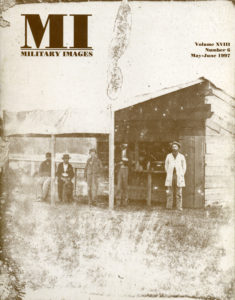The complete issue
Vol. XVIII, No. 6
(40 pages)
Print edition: Visit our store to check availability
Digital edition: Visit JSTOR.org to purchase
Subscribe to MI
Explore the MI Archives: Browse | Advanced search | Tutorial
Inside
Cover image
From the Robert Lyon Collection, an outdoor portrait titled “A Slow Day at the Sutler’s,” is Plate No. 108 in Alexander Gardner’s classic book, Photographic Sketchbook of the War.
Table of Contents (p. 1)
Editor’s Desk (p. 3)
The editor introduces readers to Jerry Russell, “The strongest voice in the Battlefield Preservation movement. Jerry is head of Civil War Round Table Associates, a non-profit umbrella that carries news to and from the hundreds of CW Round Tables in the country.”
Mail Call (pp. 4-5)
Letters include feedback about the recent Philadelphia National Guards feature, kudos to Chris Nelson for his fascinating story about Brig. Gen. Augustus “Augie” Corliss, and praise for The Auction Block and Captain Bob’s Caveat Emptorium.
Heavy Headgear: Soldierly Chapeaux from the Official to the Outlandish (pp. 6-18)
The staggering variation in headgear from the antebellum years through World War I is examined in seven groupings: Officers, Variations on the Kepi, Comfort in Camp, Shakos & Sombreros, The Helmet Blossoms, Odds & Sods of The Haberdashers from Hell and End of an Era. A total of 50 portraits are included.
Civil War Patriotic Covers by Bruce Mowday (pp. 19-21)
Billed as “another sort of military images,” the author tells the story of how patriotic covers he purchased at a 1995 Civil War Show started him on a path to learn more about the origins and history these illustrated envelopes. The narrative is illustrated with 14 examples.
William T. Sampson: Naval Biography by Jerry Harlowe (p. 22)
New York born and Naval Academy educated William Thomas Sampson served his first post-graduation combat assignment off Charleston, S.C., on the ironclad Patapsco in 1864. The story of his pre-combat assignments and his post-war military life is told here, illustrated by two portraits.
Midshipman Thompson’s Trumpet by Davis M. Sullivan (p. 23)
Robert Means Thompson’s zealous efforts to master bugle calls prompted Vice Adm. David Dixon Porter to issue a stern warning to the midshipman. Porter’s order, and the rest of Thompson’s life and military career, is detailed here. The narrative is illustrated with the subject’s portrait.
The Royal Navy at Charleston, S.C., 1863 by David Norris (pp. 24-27)
This investigation into a photograph of the Confederate ironclad Chicora revealed little known and controversial activities of the British Navy during the Civil War. The Chicora photograph and a wartime engraving of the Union fleet illustrate the text.
The Will That Started a War: Major Emil Fritz, Billy the Kid and the Lincoln County War by Charles Anegan (pp. 28)
Emil Fritz had a relatively uneventful military career as a captain in the 1st California Cavalry during the Civil War. His 1873 will was a different story. According to the author, it set the spark to the tinder that was the bloody Lincoln County War.
The Auction Block (p. 29)
Capt. Bob’s Caveat Emptorium (p. 30)
In this installment, the sly captain tries to sell readers a U.S. sharpshooter portrait. But let the buyer beware! Looks can be deceiving, as is certainly the case here.
Stragglers (pp. 31-34)
Seven images are featured, including a postwar camp scene, a group of soldiers with tin cups and other camp wares, a World War I era image of two women boxing and more.
Light & Shadow (p. 35)
In this installment of technical aspects of photography and collecting, David Norris shares an article from the March 26, 1864, issue of the Raleigh, N.C. Confederate. The gist of the story is that a photographer was called in to make an image of a murdered man’s eyes to see if the reflection of the face of the killer could be seen. According to the report, it was.
Uniforms & History by Michael J. McAfee (pp. 36-37)
In “‘The Polish Legion,’ Company, C, 31st New York Volunteer Infantry,” McAfee examines the distinctive uniform and record of this Empire State regiment. The column is illustrated with a drawing by the author, a portrait of a “Col. Rasinski,” and a stereoview of volunteers at Park Barracks, N.Y., where the regiment was organzed.
Passing in Review (p. 38)
Four publications are mentioned, including The Civil War in Books, an Analytical Bibliography (University of Illinois Press) by David Eicher, Encyclopedia of United States Army Insignia and Uniforms (University of Oklahoma Press) by William K. Emerson, A Generation on the March: The Union Army at Gettysburg (Thomas Publications) by Edmund J. Raus and Capital Navy: Confederate Naval Operations on the James River (Savas Woodbury) by John M. Coski.
Sutlers’ Row (pp. 39-40)
Back cover
A civilian-to-soldier double exposure carte de visite from the Robert Lyon Collection.



































